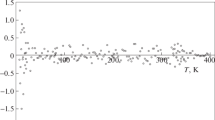Abstract
The thermodynamic properties of amorphous polyphenylquinoxaline in the temperature range of 6 to 570 K are studied via precision adiabatic vacuum calorimetry and differential scanning calorimetry. The thermodynamic characteristics of glass transition are determined. Standard thermodynamic functions C°p, H°(T) − H°(0), S°(Т) − S°(0), and G°(T) − H°(0) in the range of T → 0 to 570 K and the standard entropy of formation at T = 298.15 K are calculated. The low-temperature (T ≤ 50 K) heat capacity is analyzed using a multifractal model for the processing of heat capacity, fractal dimension D values are determined, and conclusions on the topological structure of the compound are drawn.
Similar content being viewed by others
References
Polyimides and Other High Temperature Polymers. Synthesis, Characterization, and Applications, Ed. by K. L. Mittal (VSP, Utrecht, Boston, 2005), Vol. 3.
E. S. Krongauz, Vysokomol. Soedin., Ser. A 26, 227 (1984).
V. V. Korshak, E. S. Krongauz, and A. P. Travnikova, Vysokomol. Soedin., Ser. A 22, 1450 (1980).
A. L. Rusanov, T. A. Stadnik, and K. Müllen, Russ. Chem. Rev. 68, 685 (1999).
M. Jomdke, P. Strohriegl, S. Berleb, et al., Macromolecules 31, 6434 (1998).
M. E. Wieser, N. Holden, T. B. Coplen, et al., Pure Appl. Chem. 85, 1047 (2013).
N. Baird, J. W. Dittmar, Y. B. Losovyj, et al., ACS Appl. Mater. Interfaces 9, 2285 (2017).
R. M. Varushchenko, A. I. Druzhinina, and E. L. Sorkin, J. Chem. Thermodyn. 29, 623 (1997).
V. M. Malyshev, G. A. Mil’ner, E. L. Sorkin, et al., Prib. Tekh. Eksp. 6, 195 (1985).
G. W. H. Hohne, W. F. Hemminger, and H. F. Flammersheim, Differential Sanning Calorimetry (Springer, Berlin Heidelberg, 2003).
V. A. Drebushchak, J. Therm. Anal. Calorim. 79, 213 (2005).
T. S. Yakubov, Dokl. Akad. Nauk 310, 145 (1990).
V. B. Lazarev, A. D. Izotov, K. S. Gavrichev, and O. V. Shebersheneva, Thermochim. Acta 269, 109 (1995).
S. Alford and M. Dole, J. Am. Chem. Soc. 77, 4774 (1955).
G. Adam and J. U. Gibbs, J. Chem. Phys. 43, 139 (1965).
W. Kauzmann, Chem. Rev. 43, 218 (1948).
B. V. Lebedev, Thermochim. Acta 297, 143 (1997).
J. D. Cox, D. D. Wagman, and V. A. Medvedev, CODATA Key Values for Thermodynamics (Hemisphere, New York, 1984).
M. W. Chase, Jr., J. Phys. Chem. Ref. Data: Monograph, No. 9, 1 (1998).
Author information
Authors and Affiliations
Corresponding author
Rights and permissions
About this article
Cite this article
Smirnova, N.N., Markin, A.V., Samosudova, Y.S. et al. Thermodynamic Properties of Polyphenylquinoxaline in the Temperature Range of T → 0 to 570 K. Russ. J. Phys. Chem. 92, 226–231 (2018). https://doi.org/10.1134/S0036024418020206
Received:
Published:
Issue Date:
DOI: https://doi.org/10.1134/S0036024418020206




